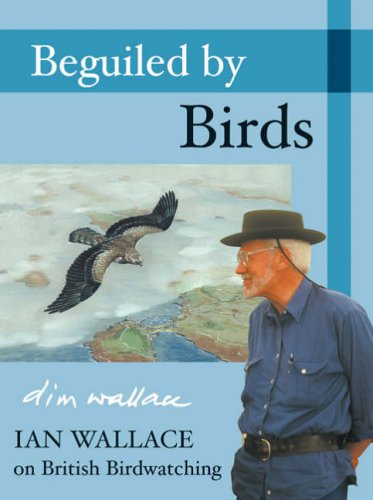
Donald Ian Mackenzie Wallace, (dim wallace as his artist’s signature was), known most usually as Ian Wallace, passed away in his sleep last Thursday night at the age of 88, not far short of his 89th birthday on 14 December.
He was a writer, very definitely an artist, and a leading ornithological figure for a period of at least half a century. As a teenage birder I remember coming across his words and his artwork in British Birds – usually in helpful articles about identifying rare birds. He seemed then, as he was, a very knowledgable and cultured birder with an independent mind and a good eye. He knew his birds from close observation and hours in the field.
In more recent years, I’ve felt privileged to get occasional letters (Ian didn’t do email) from the great man; beautifully written letters (both in typography and grammar) asking for advice. Ian Wallace – asking me for advice! When I left the RSPB, Ian was one of those who, rather out of the blue as far as I was concerned, wrote to me with kind words about how I’d performed – that was very touching. In recent years the increasingly stooped figure, wearing a kilt and a tartan bonnet, would identify Ian in the crowd and I treasured the conversations we had at those times – always upbeat, always about birds, always a joy.
Ian was born of Scottish parents in Norfolk and went to prep-school and boarding school near Edinburgh, and his first ornithological memory was being shown a Puffin on Shetland by his father at the age of 4. When he reached the age of 18 he was subject to National Service and served wth the King’s African Rifles in Kenya (1952-54) which gave him plenty of opportunity for birding – not only of African species but of Palearctic migrants spending our winters in the Rift Valley. He wrote up his observations – which was characteristic of the man throughout his life. Wherever work took him, West African for Nigerian Breweries, Hull in the fish trade, and London, he documented his observations.
Ian served on many committees from those of bird observatories to the RSPB, BTO and BOU, to the British Birds Rarities Committee. He was the author of many books, all well worth reading still, and the illustrator of others (including Birds of the Western Palearctic, for which he was also the editor of the Field Characteristics section).
His artwork was of a very high standard and combined an artist’s skill in composition with a birder’s attention to plumage detail. And most are simply very attractive. And his writing was a joy too – erudite, opinionated and independent.
When Ian talked to my mate Keith Betton for Behind the Binoculars, he mentioned that two of the people he liked best on his patch were gamekeepers who did more by providing winter bird food than did the undisciplined subsidies received by farmers and that the Game and Wildlife Conservation Trust was more in touch with reality on the ground than the RSPB.
I wonder whether Ian’s passing marks the end of an era – to some extent it must, but it also feels as though he may be the last of a generation who got into birding before or during the Second World War and went on to make major contributions afterwards, and for a very long and sustained period. More of those whose lives we celebrate in future will have worked in some ornithological role rather than being brilliant amateurs making their contributions around their jobs.
Donald Ian Mackenzie Wallace was a one-off – we shall not see his like again, and it was a privilege to have known him a little.
[registration_form]
An ornithologist/birdwatcher of considerable merit, even if controversial at times. I have had the pleasure of meeting him a couple of times and heard him talking at various venues. I am lucky enough to have on my wall a drawing he did to illustrate a British Birds article that he wrote on the i.d of American ‘peeps’ (small sandpipers for those who don’t know the term). As you said his like will not be seen again, which is very sad.
Ian Wallace was, without doubt, one of the most important and influential individuals in my ‘birding’ life, even though we never met in person. His delightful and insightful guide ‘Bird’s By Character’, gave me a bit of a eureka moment, “finally” I thought, “this is someone who watches birds in the same way I do” and it helped me to crystalize my thought processes. I’ve been running birdwatching courses for nearly thirty years now, using the character of birds as a principal tool to aid identification. I’ll be forever indebted to Ian for providing me with a lifetime of inspiration.
I would recommend DIMW’s Discover Birds for every young birder. When I started birding I would read and reread his accounts of those best days in the field and I was completely enthralled.
His “patch” was just over our county boundary, heard him talk at our ornithological society’s 60th, very entertaining.
Like many experienced field men of his time, he seems to have been able to hold a balanced view of gamekeeping and its many benefits.
I’m intrigued by your mention of Ian’s work in the Hull fish trade. I wonder if you know of any more detail. My father, a Hull fish merchant, was a similar age.
Ian’s father worked for the Bloomfield herring fishing company. So that may have something to do with it.
Discover Birds, with its distinctive landscape format, was a huge influence on the ten-year old me. Huge. As much the words and places described as the fantastic artwork. Never met the man, but I am saddened by his passing: it feels like he takes some of the gleeful wide-eyed passion of my youthful birding with him. RIP.